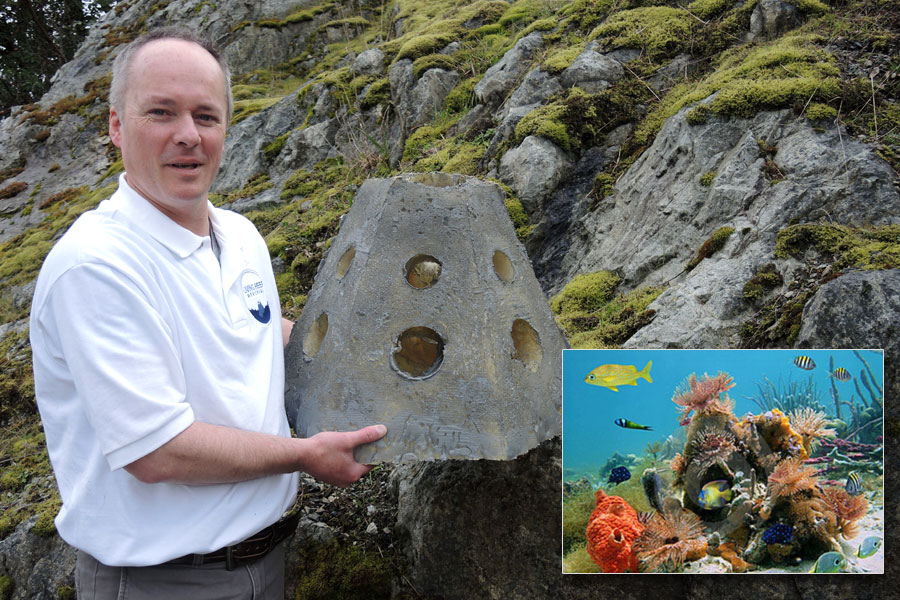At-sea burials going green
By Lookout on May 17, 2018 with Comments 1

Kevin Owens owner of Ladysmith-based Living Reef Memorial, displays a model of a cement container. Owens fills the real containers with cremated human remains that are then used to build living reef systems on the ocean floor. Photo by Peter Mallett, Lookout
Peter Mallett, Staff Writer ~
A funeral home operator says environmental awareness is driving people’s interest in a new take on burials at sea: the Living Reef Memorial.
Kevin Owens, who operates Evergreen Cremations Centre of Ladysmith, B.C., purchased the Canadian rights to the United-States based company Living Reef Memorial last year. The concept involves taking cremated human remains, encasing the ashes in concrete and then placing them on the seabed floor to create new coral reef systems.
Owens says his company is an environmentally-friendly alternative to conventional methods of burial. Over 90 million board feet of rainforest hardwoods are consumed each year for the sole purpose of casket making. Add to that, the toxicity of casket materials and embalming fluid along with the large amount of land that cemeteries occupy.
“The world is going green and green options for funerals are a huge part of the funeral industry today,” said Owens. “When you scatter your remains in the ocean they are gone forever, but this way your remains have purpose and you will become part of a living reef which will help the ocean.”
The process works like this: the human remains become toxin free during the cremation process and are then combined with clean sand, crushed oyster shells and a low alkaline cement to create a reef block. The reef blocks containing the remains are then placed on the ocean floor at distances of less than 300 yards off the coast at depths that range from 45 to 75 feet.
“Once installed on the ocean floor it takes only a short time for the fish to start colonizing the reefs,” said Owens. “Once the reefs become colonized, they grow in size and bloom with an abundance of marine life.”
Owens, 46, was a member of the Navy League of Canada in the late 1970s. His father David Owens worked as a military photographer in the 1950s and 60s. His step father Gordon Shields was a career sailor and chief engineer who served in Canadian warships HMCS Protecteur and HMCS Qu’Appelle.
He opened the Evergreen Cremations Centre in Ladysmith, B.C., in 2015 after previously operating a funeral home in Duncan for 12 years. California-based Living Reef Memorial began operations in 2000 and Owens heard about the concept a few years ago.
His operation now has multiple internment sites around Vancouver Island including Spring Bay in Victoria, Gabriola Island, Salt Spring Island and Pipers Lagoon in Nanaimo. Prices for the burials range from $600 to $4,000 and do not include at-sea memorial services. Those are provided by the family.
Before his business could begin interning the remains of the dead on the sea floor, he needed to go through an approval process. That included a review of his business plan by three Federal Government agencies: Transport Canada, Environment Canada and Fisheries and Oceans Canada. The process required Owens to prove that burials would not harm marine life or obstruct marine traffic. The approvals give him the rights to bury remains in sea or fresh water, anywhere in Canada with certain limitations.
In 2017 his business made 14 burials, but he is targeting 38 for this year. He says many of his customers have personal ties to the ocean and want to be permanently connected to it.
“One man was an Oceanographer and spent his career mapping the ocean floor, another was a former tugboat operator from Port Alberni,” said Owens. “Their lives were both tied to the ocean; it gave them their livelihoods and they both wanted to give life back to the ocean.”
For more information about the burial process and pricing, visit Owens’ website at www.livingreefmemorial.ca.
Stay connected, follow Lookout Navy News:
Facebook: LookoutNewspaperNavyNews
Twitter: @Lookout_news
Instagram: LookoutNavyNews
Filed Under: Top Stories
About the Author:






It’s awesome that there’s a way to lay the dead to rest without building cemeteries or harming the environment! As a kid, I loved learning about marine life and I wanted to find ways to help them. This form of burial at sea seems like an excellent way to help the environment even after passing away.